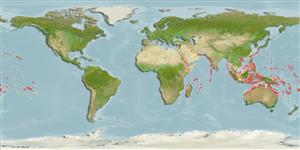>
Blenniiformes (Blennies) >
Blenniidae (Combtooth blennies) > Salariinae
Etymology: Exallias: Greek, exallias = strange, marvellous (Ref. 45335).
More on author: Kner.
Environment: milieu / climate zone / depth range / distribution range
Écologie
marin récifal; profondeur 3 - 20 m (Ref. 9710), usually 3 - 8 m (Ref. 58302). Tropical; 30°N - 30°S
Indo-Pacific: Red Sea south to Sodwana Bay, South Africa (Ref. 4404) and east to the Hawaiian, Marquesan, and Society islands, north to the Ryukyu and Bonin islands, south to New Caledonia and Rapa.
Taille / Poids / Âge
Maturity: Lm ? range ? - ? cm
Max length : 14.5 cm TL mâle / non sexé; (Ref. 9710)
Épines dorsales (Total): 12; Rayons mous dorsaux (Total): 12-13; Épines anales 2; Rayons mous anaux: 14 - 15. Numerous papillae on the upper lip, smaller and more closely spaced spots. Nuchal cirri: 30 - 36.
Adults occur on clear coastal reefs, often in bays and semi-exposed habitats (Ref. 48636). Found on the seaward edge of reefs, among corals like Acropora, Pocillopora, Seriatopora, Porites, and Millepora where they feed on coral tissues (Ref. 1602). Benthic (Ref. 58302). Males prepare nesting sites by overgrazing a patch of coral (Ref. 9710). Oviparous. Eggs are demersal and adhesive (Ref. 205), and are attached to the substrate via a filamentous, adhesive pad or pedestal (Ref. 94114). Larvae are planktonic, often found in shallow, coastal waters (Ref. 94114). Minimum depth reported taken from Ref. 30874.
Life cycle and mating behavior
Maturité | Reproduction | Frai | Œufs | Fécondité | Larves
Oviparous, distinct pairing (Ref. 205).
Myers, R.F., 1991. Micronesian reef fishes. Second Ed. Coral Graphics, Barrigada, Guam. 298 p. (Ref. 1602)
Statut dans la liste rouge de l'IUCN (Ref. 130435)
Menace pour l'homme
Harmless
Utilisations par l'homme
Aquarium: Commercial
Plus d'informations
RéférencesAquacultureProfil d'aquacultureSouchesGénétiqueElectrophoresesHéritabilitéPathologiesTraitementNutrientsMass conversion
CollaborateursImagesStamps, Coins Misc.SonsCiguateraVitesseType de nageSurface branchialeOtolithesCerveauxVision
Outils
Articles particuliers
Télécharger en XML
Sources Internet
Estimates based on models
Preferred temperature (Ref.
123201): 24.7 - 29.3, mean 28.3 °C (based on 3063 cells).
Phylogenetic diversity index (Ref.
82804): PD
50 = 1.0000 [Uniqueness, from 0.5 = low to 2.0 = high].
Bayesian length-weight: a=0.01995 (0.00906 - 0.04395), b=3.01 (2.83 - 3.19), in cm total length, based on all LWR estimates for this body shape (Ref.
93245).
Niveau trophique (Ref.
69278): 4.3 ±0.4 se; based on diet studies.
Résilience (Ref.
120179): Haut, temps minimum de doublement de population inférieur à 15 mois (Preliminary K or Fecundity.).
Fishing Vulnerability (Ref.
59153): Low vulnerability (10 of 100).
Nutrients (Ref.
124155): Calcium = 83.8 [40.2, 156.6] mg/100g; Iron = 0.645 [0.353, 1.107] mg/100g; Protein = 18.9 [17.7, 20.1] %; Omega3 = 0.129 [0.074, 0.219] g/100g; Selenium = 20.8 [10.8, 43.3] μg/100g; VitaminA = 104 [29, 361] μg/100g; Zinc = 1.16 [0.74, 1.74] mg/100g (wet weight);
